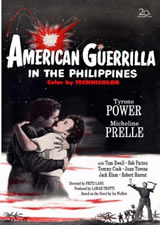Plot
In April 1942 in the Philippines, an American motor torpedo boat is destroyed by Japanese planes. The survivors, among them ensign Chuck Palmer, reach the shore of Cebu and their commander orders them to separate. Chuck pairs with Jim Mitchell and reaches Colonel Benson on Leyte, only to be told that he has been ordered by general Douglas MacArthur to surrender his forces soon.
Chuck helps Jeanne Martinez, a Frenchwoman married to a Filipino planter, acquire medical assistance for a pregnant woman. Jeanne pleads with Chuck to stay and fight, but he buys an outrigger canoe and recruits a crew of Air Corps soldiers in a desperate but unsuccessful attempt to sail to Australia. When the boat founders, the crew is rescued by Miguel, a member of the Filipino resistance. The Americans evade capture and Chuck eventually meets Jeanne again, as well as her husband Juan, a secret supporter of the resistance movement.
Chuck is ordered to stay in the Philippines to help establish a stay-behind network to gather intelligence on the Japanese. Later, Juan is beaten to death in front of Jeanne in an attempt to reveal the location where the guerrillas are hiding. Jeanne joins the resistance and is reunited with Chuck at Christmas 1943, and they begin to fall in love.
After three years of fighting, Chuck, Jeanne, Jim and the rest of their band are trapped in a church by a Japanese patrol. Just when it looks as if they will be killed, squadrons of American planes appear overhead and explosions are heard, announcing that the liberation of the Philippines is under way. The Japanese leave to face the greater threat.
Production
The film is based on the story of U.S. Navy ensign Iliff "Rich" Richardson, the executive officer of PT 34 , [4] which was sunk by the Japanese. Richardson and a dozen fellow Americans attempted to sail a native outrigger to Australia, but the boat was sunk in a storm. He eventually joined the Philippine guerrilla forces, establishing a radio network to keep the various bands in touch with each other and Allied forces in Australia. After the liberation of the Philippines, Richardson dictated his memoirs to war correspondent Ira Wolfert, who published them in 1945 as An American Guerilla in the Philippines. The book became a Book of the Month Club selection and was published in condensed form in the March 1945 issue of Reader's Digest . [5]
Darryl F. Zanuck of Twentieth Century-Fox bought the film rights and commissioned Lamar Trotti to write a screenplay by August 1945. [6] The original plan was to film in Puerto Rico with Fred MacMurray and William Bendix under the direction of Henry King, and later the plan changed to involve John Payne and Linda Darnell, to be filmed on Catalina Island. [5] The end of the war led Zanuck to shelve all films with a World War II theme.
In 1950, American Guerrilla in the Philippines became the first American film to be shot on location in the Philippines in color. Fritz Lang directed the film but later said that it was his least favorite. When the film premiered in the Philippines, protests and the threat of a proposed boycott were raised because the names of Filipino actors were omitted from the credits. In response, the studio replaced the onscreen credits of several crew members with a new Technicolor card crediting 17 Filipino actors. [5] Zanuck, who also worked on the script and edited it, rushed the film's completion to correspond with the start of the Korean War. [7]
This page is based on this
Wikipedia article Text is available under the
CC BY-SA 4.0 license; additional terms may apply.
Images, videos and audio are available under their respective licenses.
